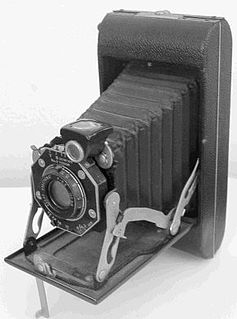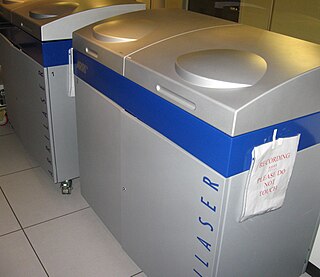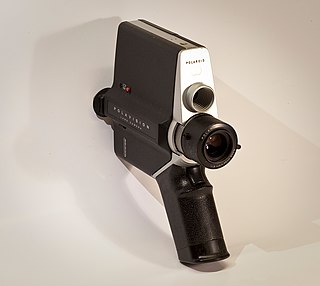Related Research Articles

A folding camera is a camera type. Folding cameras fold into a compact and rugged package for storage. The lens and shutter are attached to a lens-board which is connected to the body of the camera by a light-tight folding bellows. When the camera is fully unfolded it provides the correct focus distance from the film. The key advantage of folding cameras is their excellent physical-size to film-size ratio when the camera is folded for storage.
Polaroid is an American company that is a brand licensor and marketer of its portfolio of consumer electronics to companies that distribute consumer electronics and eyewear. It is best known for its Polaroid instant film and cameras. In 2000, its parent company was acquired by Polish investor Oskar Smołokowski.

The Land Camera is a model of self-developing film camera manufactured by Polaroid between 1948 and 1983. It is named after their inventor, Edwin Land, who developed a process for self-developing photography between 1943 and 1947. After Edwin Land's retirement from Polaroid, the name 'Land' was dropped from the camera name. The first commercially available model was the Model 95, which produced sepia-colored prints in about 1 minute. It was first sold to the public on November 26, 1948.
Photographic processing or photographic development is the chemical means by which photographic film or paper is treated after photographic exposure to produce a negative or positive image. Photographic processing transforms the latent image into a visible image, makes this permanent and renders it insensitive to light.

The instant camera is a type of camera which uses self-developing film to create a chemically developed print shortly after taking the picture. Polaroid Corporation pioneered consumer-friendly instant cameras and film, and were followed by various other manufacturers.

In photography, reversal film is a type of photographic film that produces a positive image on a transparent base. The film is processed to produce transparencies or diapositives instead of negatives and prints. Reversal film is produced in various sizes, from 35 mm to roll film to 8×10 inch sheet film.

A darkroom is used to process photographic film, to make prints and to carry out other associated tasks. It is a room that can be made completely dark to allow the processing of the light-sensitive photographic materials, including film and photographic paper. Various equipment is used in the darkroom, including an enlarger, baths containing chemicals, and running water.

A film recorder is a graphical output device for transferring images to photographic film from a video source. In a typical film recorder, an image is passed from a host computer to a mechanism to expose film through a variety of methods, historically by direct photography of a high-resolution cathode ray tube (CRT) display. The exposed film can then be developed using conventional developing techniques, and displayed with a slide or motion picture projector. The use of film recorders predates the current use of digital projectors, which eliminate the time and cost involved in the intermediate step of transferring computer images to a separate display medium, instead directly displaying the image signal from a computer.

Instant film is a type of photographic film introduced by Polaroid to be used in an instant camera. The film contains the chemicals needed for developing and fixing the photograph, and the instant camera exposes and initiates the developing process after a photo has been taken.

The SX-70 is a folding single lens reflex Land camera which was produced by the Polaroid Corporation from 1972 to 1981.
A film holder is a device that holds one or more pieces of photographic film, for insertion into a camera or optical scanning device such as a dedicated film scanner or a flatbed scanner with film scanning capabilities. The widest use of the term refers to a device that holds sheet film for use in large format cameras, but it can also refer to various interchangeable devices in medium format or even 135 film camera systems.
Polaroid Type 55 film is a black-and-white peel-apart Polaroid film that yields both a positive print and a negative image that can be used to create enlargements.

Analog photography also known as Film Photography, uses a physical, non-electronic recording medium, where light is captured by sensitive silver particles, and the image will remain printed when processed chemically. This method was traditionally used for more than a century, prior to more recent Digital Photography based on electronic sensors.

Dufaycolor is an early British additive colour photographic film process, introduced for motion picture use in 1932 and for still photography in 1935. It was derived from Louis Dufay's Dioptichrome plates, a glass-based product for colour still photography, introduced in France in 1909. Both Dioptichrome and Dufaycolor worked on the same principles as the Autochrome process, but achieved their results using a layer of tiny colour filter elements arrayed in a regular geometric pattern, unlike Autochrome's random array of coloured starch grains. The manufacture of Dufaycolor film ended in the late 1950s.

Polavision was an "instant" color home movie system launched by Polaroid in 1977.

Polaroid art is a type of alternative photography which consists of modifying an instant picture, usually while it is being developed. The most common types of Polaroid art are the emulsion lift, the Polaroid transfer and SX-70 manipulation.

Photographic film is a strip or sheet of transparent plastic film base coated on one side with a gelatin emulsion containing microscopically small light-sensitive silver halide crystals. The sizes and other characteristics of the crystals determine the sensitivity, contrast, and resolution of the film.
Polaroid Originals is a Dutch photography company and manufacturer founded in 2008 by Florian Kaps, André Bosman and Marwan Saba. It manufactures its own cameras, the Impossible I-1, the OneStep 2, the OneStep+, modelled on the original Polaroid OneStep Land Camera, the i-Type instant film for its original cameras, and instant film for select Polaroid Corporation instant cameras.
Gail Thacker is a visual artist most known for her unique use of type 665 Polaroid positive/negative film in which her subjects—friends, lovers, the city—become intertwined with the process and chemistry of her photos. She attended the School of the Museum of Fine Arts at Tufts and has lived and worked in New York City since 1982. She is part of a group of artists called The Boston School.
In medical testing, and more generally in binary classification, a false positive is an error in data reporting in which a test result improperly indicates presence of a condition, such as a disease, when in reality it is not present, while a false negative is an error in which a test result improperly indicates no presence of a condition, when in reality it is present. These are the two kinds of errors in a binary test They are also known in medicine as a false positivediagnosis, and in statistical classification as a false positiveerror. A false positive is distinct from overdiagnosis, and is also different from overtesting.
References
- ↑ Bockelmann, WD (Jun 1975). "The new polaroid positive/negative film type 105 for ophthalmology (author's translation)". Klinische Monatsblätter für Augenheilkunde (in German). 166 (6): 847–9. PMID 1214411.
- ↑ Conrad, Fred R. (June 8, 2009). "Shoptalk: Polaroid's Quirky Films". The New York Times . Retrieved June 8, 2009.
| This photography-related article is a stub. You can help Wikipedia by expanding it. |